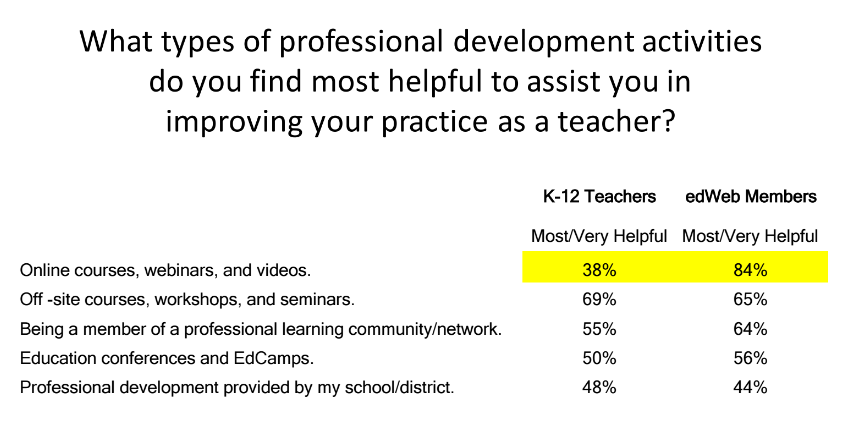Ask school leaders what is needed to help teachers integrate technology into teaching and learning, and they’ll tell you that teachers need more professional learning and support. At a recent Consortium for School Networking’s (CoSN) conference, educational consultant and retired superintendent Gabe Soumakian summed it up concisely, “It’s not about the tech, it’s about the professional learning.”
Providing teachers—and all educators—with the professional learning they need is a daunting task. Online professional development may hold the key.
There are some 5 million teachers in the U. S. working in 125,000 schools, spread across 16,000 school districts and 50 states. According to the 2012 - 2013 SIMBA Professional Development Forecast, these teachers are mandated by their schools and districts to participate in an average of 21 to 26 hours of professional development each year. But the decentralization of our education system makes it difficult to do this efficiently and effectively.
Indeed, a study by the New Teacher Project found that although $18 billion is spent on teacher PD annually, much of it doesn’t help. The programs are often too sporadic and disconnected from what teachers actually need.
Traditional professional development programs are often criticized for not helping teachers and administrators keep up with the pace of change and increased use of technology in education today. The model of periodic, face-to-face professional development, provided primarily within the school district, is often:
- Focused on teachers (administrators need professional learning, too)
- In the form of sit-and-get programs that are not engaging
- Made up of one-time events that do not provide sustained learning and practice
- Not relevant to classroom practice
- Not connected to other educators and peers around the country or the world
But that is changing. We’re at the dawn of a new era in professional learning, one brought on by the creation of social networking, content-sharing, and collaborative technology. In contrast to the challenges of traditional professional development, new developments in professional learning:
- Are online and available anytime, anywhere
- Offer continuous, collaborative learning
- Are relevant to educators’ needs
- Engage the entire educator community
- Help practicing educators share what really works with their peers
Teachers and educators at all levels are exploring a wide range of both general and professional websites for professional learning. These include Twitter, Pinterest, YouTube, edWeb.net, Teachi ng Channel, and Sim pleK12. Their blogs, discussion forums, chats, video conferencing, messaging, file sharing, etc., allow for a more collaborative experience for educators and enable more direct peer-to-peer sharing of information and practices, and the development of a personal learning network.
We Asked the Teachers
To better understand the types of PD teachers find most helpful to improve teaching practice and students’ learning, edWeb asked educators themselves.
This past March, we surveyed 400,000 K-12 teachers nationwide, 150,000 of them edWeb preK-12 members. edWeb.net is a free professional learning and social network that makes it easy for educators to collaborate, share innovative ideas, and improve teaching and learning. We provide the support and training educators need to advance their practice, build better schools, and prepare students for lifelong learning and success.
Perhaps the most striking finding from our survey was how highly our members value online professional development vs. other forms of PD.

These results could indicate that we have attracted educators who are already inclined to prefer online learning, or that the experience of being a member of our community has been a valuable learning experience, or some combination of both.
Overall, most teachers ranked You Tube as the most valuable professional learning resource. Our community members, however, ranked edWeb as their favorite PD resource. Educators tell us on a daily basis how much they value the professional learning we provide.

“With edWeb I can plan professional development in a way that is meaningful to each and every teacher, in any content area, and that is really, really exciting. Teachers can watch a webinar on their own time, reflect, then share. The feedback has been phenomenal, even from our new learners, the self-proclaimed tech newbies.” —Rachel Langenhorst, Technology Integrationist at Rock Valley School District in Iowa
All of the respondents to the survey expressed similar reasons for why they participate in teacher professional development programs.

Educators are collaborative by nature and are generous and willing share with their peers, but many still prefer face-to-face learning or are hesitant to try new technology or join a social network. Our recent survey illustrates that if you create the kind of collaborative, supportive, relevant programs that teachers love, online professional learning can indeed surpass face-to-face programs and deliver a more rewarding and more relevant experience.



